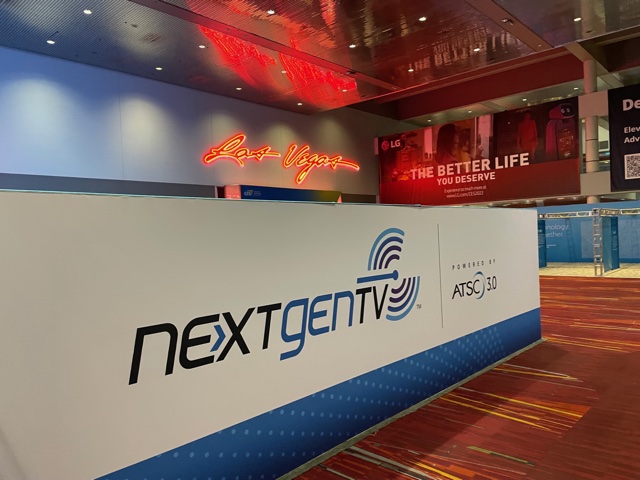Free Over-The-Air TV Is Getting Even Better

Cutting the cable cord is easier than ever, thanks to the growing options of NextGen TV. Sports, local news, network TV shows and more, all for free. An inexpensive antenna is all you’ll need to get get ABC, CBS, Fox, NBC and PBS stations in most major cities across the country. Over-the-air TV, aka the way most Americans got their TV for most of the latter half of the 20th century, has gotten a huge upgrade.

Most of ATSC 3.0’s audio delay in the U.S. is attributable to the same factors that have held back the rollout of UHD content: there is still a small base of NextGen TV-capable sets; the distribution chain from networks to stations is not fully ready for new formats; and broadcasters are somewhat hamstrung in experimenting with their 3.0 content because of FCC rules that require them to effectively simulcast their 1.0 programming. But despite that, progress is being made.

Evoca TV, a service that uses a blend of ATSC 3.0 broadcast signals and Internet streaming to deliver inexpensive pay-TV packages in a handful of US markets, needs more funding to avoid a shutdown. The company told subscribers via email Wednesday and in a message posted on its website that, should it be unable to raise more capital, “we are sad to say that Evoca TV will discontinue operations and programming on Dec. 31, 2022. … We will continue service for our subscribers through December but will not accept new orders at this time.”
Local TV broadcasters and emergency managers from the Washington, D.C., metro region will gather Dec. 7-8 for the AWARN Washington, D.C. Roundtable. The goal is to lay the groundwork for […]
Alp Sezen and Chris McGhay have formed PEAK3, an IoT and edge pathway solution focused on building businesses using the ATSC 3.0 broadcast spectrum. The IP-based ATSC 3.0 standard ushers in […]

The companies sign a memorandum of understanding to highlight geo-targeting capabilities, enhanced GPS, software updates, in-vehicle entertainment, real-time emergency information and more.

Consumers will gain expanded access to affordable accessory devices that will bring NextGen TV service to sets not equipped with ATSC 3.0 tuners.

KITV, KGMB, KHON, KHNL, KHII and KIKU are now broadcasting with ATSC 3.0 technology.
A recent webinar sponsored by AutoMobility Advisors and ONE Media 3.0 examined the potential and challenges of NextGen Broadcast spectrum (ATSC 3.0) to transport data to connected vehicles. The event […]
AutoMobility Advisors, a connected auto industry strategist, and ONE Media 3.0, a subsidiary of Sinclair Broadcast Group, have set a series of three webinars focused on how NextGen Broadcast/Multicast can […]

KAKE, KWCH, KSAS, KSNW, KPTS, KSCW and KMTW are now broadcasting with ATSC 3.0 technology.

FCC Commissioner Geoffrey Starks said all Americans would benefit if broadcasters became a go-to streaming competitor to the Netflixes and Amazon Prime Videos of the world, using their new ATSC 3.0 advanced-TV transmission system, and perhaps the government should help subsidize that effort.

ATSC 3.0-enabled technology will make broadcasting more like the internet, but privacy protections need to be taken seriously, Geoffrey Starks said last week in a speech at the University Of Pennsylvania Carey Law School Center For Technology, Innovation & Competition.
NextGen Rollout Challenged By Spectrum Constraints

The early consumer experience of NextGen TV has been hampered by government regulations that make it hard for viewers to differentiate the new services from the legacy ATSC 1.0 programming already delivered over-the-air, according to broadcasters. Capacity is tight for both the 3.0 and 1.0 broadcasts, and broadcasters are aggressively using video compression to make it all work. L-r: E.W. Scripps’ Kerry Oslund, Pearl TV’s Anne Schelle, Fincons Group’s Francesco Moretti and ATSC’s Madeleine Noland (Alyssa Wesley photo).

The Pearl TV coalition today announced two steps it is taking to help TV broadcasters realize more of the monetization potential of ATSC 3.0 — one related to advertising and the other aimed at increasing the number of TV viewers who can watch NextGen TV.
DigiCAP, the solution provider of ATSC 3.0 headend and the manufacturer of ATSC home gateway devices, and iWedia, part of Zappware Entertainment Group International (ZEGI) and the provider of world-class software […]
ATSC 3.0 deployments are accelerating in the U.S., driving the need for solutions that optimize the delivery of new revenue-enhancing services. At NAB Show New York (Oct. 17-20, Javits Center, […]

WSET, WDBJ, WWCW, WSLS and WZBJ are now broadcasting with ATSC 3.0 technology.

WBKI, WDRB, WAVE, WHAS and WBNA are available now in ATSC 3.0. They will be joined by WKMJ next week.

Pearl TV and iWedia have launched a fast-track program that adds new ATSC 3.0 A/344 interactive features and streamlines the adoption of NextTV by Android TV device makers.

Given a “once in a century” pandemic, no additional spectrum and “unparalleled” regulatory requirements, broadcasters say their transition to ATSC 3.0 next generation transmission technology has made “remarkable progress.” The National Association of Broadcasters made that case to the FCC in comments on the state of that transition, saying the lack of additional spectrum meant that they were trying to make the move “with one hand tied behind their backs.”

Cable operators are telling the FCC that it should continue to require broadcasters transitioning to ATSC 3.0 to deliver a signal in the current ATSC 1.0 standard, and that the programming on that signal must still be substantially similar to their ATSC 3.0 signal.

Noncommercial TV station and network representatives said they are working hard to move to the new ATSC 3.0 broadcast transmission standard and its opportunities for enhanced emergency alerts, interactive educational programming and more, but that it is a challenging change and they can’t predict when a nationwide rollout will be accomplished.
Tyche Media’s independent WCRN-LD Boston has launched an ATSC 3.0/NextGen TV platform with ENENSYS and Ateme’s ATSC 3.0 software-based solution. In addition to providing linear TV service over NextGen TV, the […]

The collaboration with Korean Broadcast System and Munhwa Broadcasting Corp. includes the development of NextGen TV technology and Data Distribution as a Service (DDaaS) business opportunities using the ATSC 3.0 broadcast standard.

The real-world test lab and trial for broadcast internet is using WatchTV’s LPTV stations that have been upgraded to ATSC 3.0

Scott Ehrlich, Sinclair Broadcast Group’s chief innovation officer, said that broadcasters are excited about NextGen TV because it will give them some of the benefits of streaming (a one-to-one interaction with a viewer) while retaining the benefits of broadcasting (a one-to-many blast to viewers). He said: “Streaming is just moving video over IP. If 3.0 is bringing internet protocol to broadcast, it’s essentially bringing broadcast into streaming.”

Initially, WCRN will offer four channels: France 24, Retro TV, Heartland TV and Paranormal TV. It’s also working with other companies to develop personalized content for viewers and unlimited encrypted datacasting services for businesses and first responders.

There is no time to waste waiting for a Broadcast Core Network to emerge, be deployed and become widely adopted if broadcasters hope to tap into the lucrative emerging market for data and entertainment delivery to vehicles, says Alchemedia founder Lynn Rowe.
The Advanced Television Systems Committee (ATSC) announced the dates for an upcoming ATSC 3.0 Jamaica Bootcamp and Seminar. The event will take place July 11-14 at the Ocean Coral Springs […]
Eurofins Digital Testing, in partnership with the Consumer Technology Association and National Association of Broadcasters, has releasee the NextGen TV logo certification test suite v 2022-1.0, the first major release […]

Six stations serving the Shreveport, La., television market today began broadcasting with NextGen TV, also known as ATSC 3.0. Switching on the new transmission standard are the Wray family’s KTBS […]

The FCC released the data as it asked for public comments on the NextGen TV transition and the sunsetting of two 3.0 rules.

Broadcasters and cable operators continue to spar over how much flexibility TV stations should have in transmitting their signals in the transition to the new ATSC 3.0 standard, specifically broadcasters’ ability to have another station transmit its digital subchannels. The idea is to ease the transition from ATSC 1.0 to the ATSC 3.0 transmission standard, also known as NextGen TV, which is not backward compatible.

KABB, WOAI, KMYS and KCWX are now broadcasting with ATSC 3.0 technology.

At last week’s ATSC conference in Detroit, Hyundai had news about an ATSC 3.0-equipped vehicle on the horizon and a bevy of new test results were shared. Above (l-r): Robert Foster of Auton, Kerry Oslund of E.W. Scripps, Coast-to-Coast test consulting engineer Merrill Weiss, Luke Fay of Sony

Samsung’s Dr. Youngkwon Lim receives the group’s highest honor, the 2022 Bernard J. Lechner Outstanding Contributor Award, while the Mark Richer Industry Leadership Medal goes to Sony Electronics for leadership in deployment of ATSC 3.0 technology.

KGPE, KMPH, KSEE, KNSO and KFRE are now broadcasting with ATSC 3.0 technology.
Pearl TV, a coalition of U.S. broadcasters transitioning to NextGen TV, today announced new field test data with Auton performed at the Motown 3.0 Open Test Track in Detroit that […]
The Broadcasting Commission of Jamaica has chosen longtime broadcast television expert Aldo Cugnini of AGC Systems to provide advisory services in support of Jamaica’s transition from analog to digital broadcasting […]








































